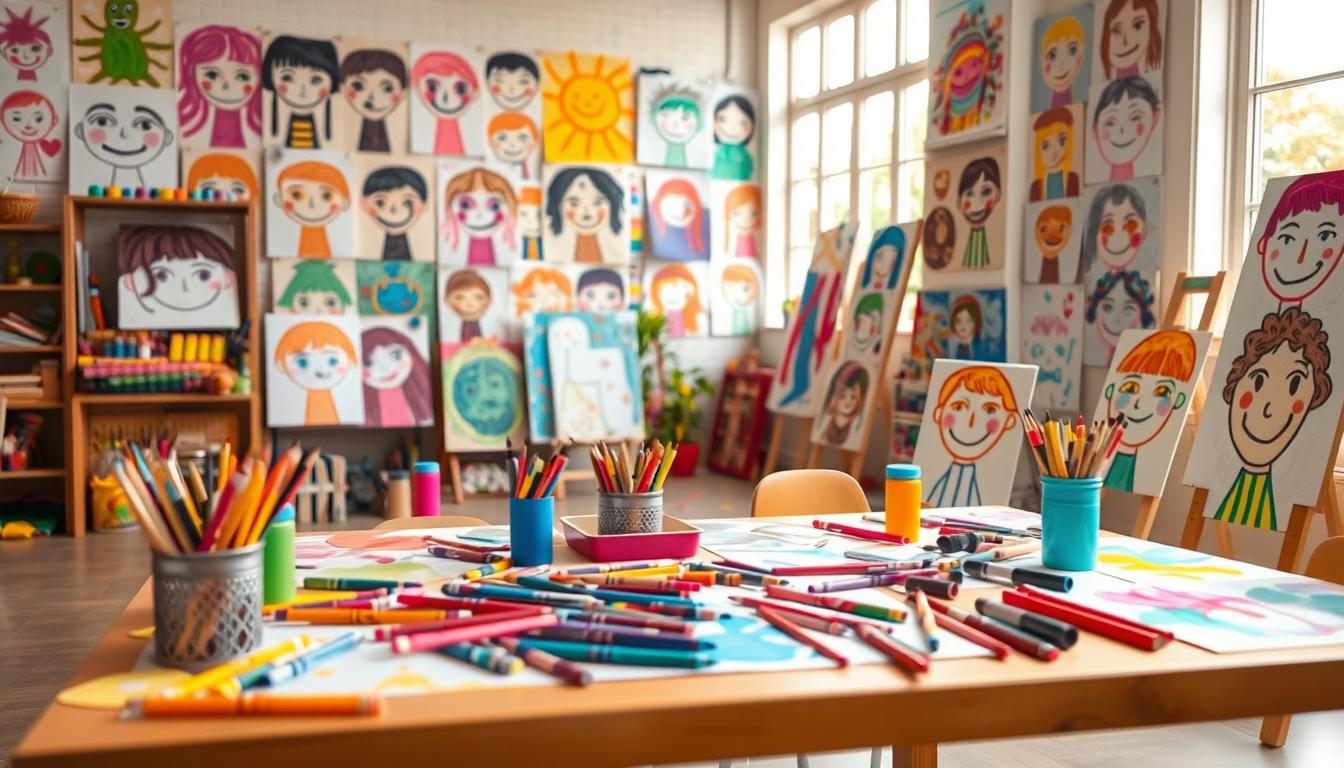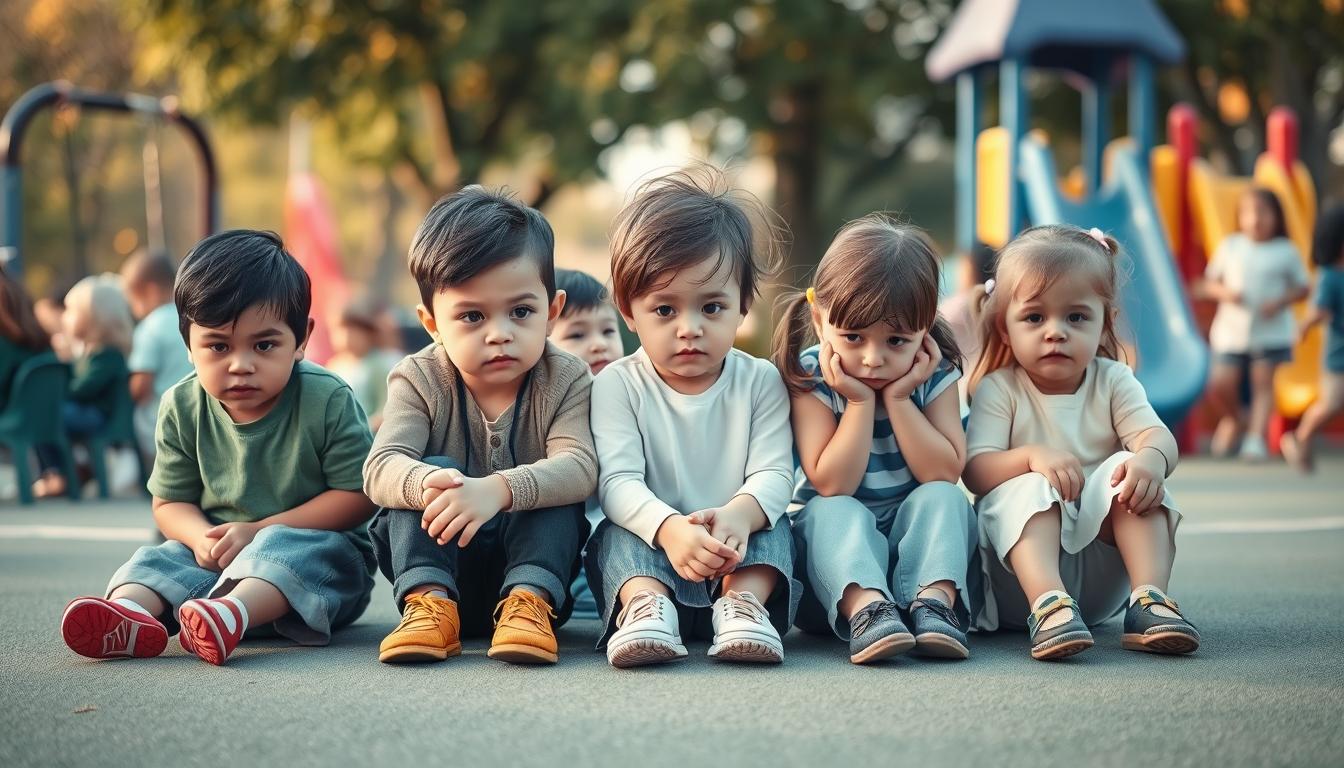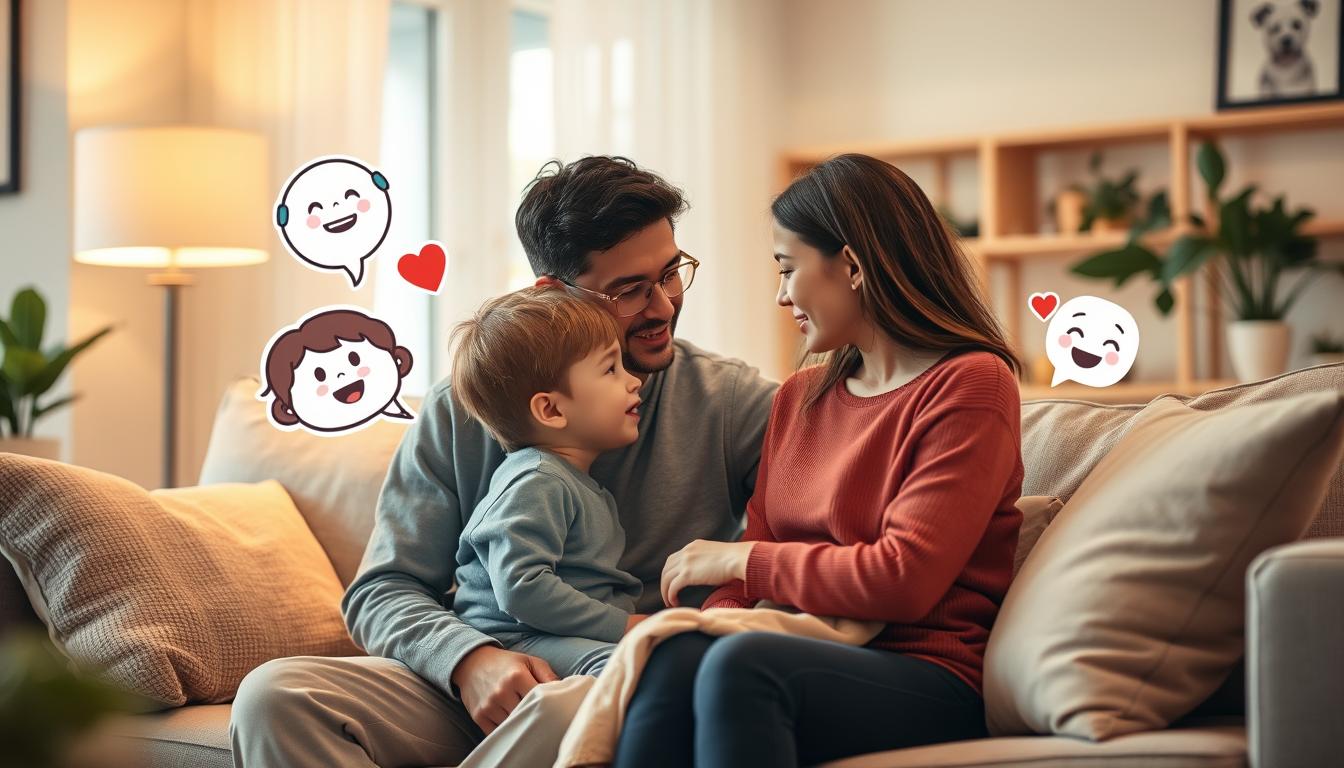Did you know that 1 in 6 children aged 2-8 years experiences a mental health disorder? Art therapy is a powerful way to help kids deal with their feelings through creative expression (Art Therapy for Kids: Creative Expression for Managing Emotions).
As a parent and child development enthusiast, I’ve seen how art therapy changes lives. Kids often find it hard to talk about their feelings. But through art, like drawing and painting, they can share their inner world clearly.
Teaching kids to manage their emotions is key. Art therapy gives them a safe place to explore and understand their feelings without fear of judgment.
My exploration into art therapy showed me its true value. It’s not just fun—it’s essential for emotional growth. Through art, kids learn about themselves, become more resilient, and find healthy ways to cope.
Key Takeaways
- Art therapy helps children express emotions they can’t verbalize
- Creative activities support emotional intelligence development
- One in six children experiences mental health challenges
- Art provides a non-threatening emotional processing method
- Creative expression builds resilience in young minds
Understanding Art Therapy and Its Benefits for Children
Art therapy is a powerful way for kids to explore their feelings. It’s a creative way to help with mental health. It lets young minds express themselves in a special way.
There’s a strong link between creativity and emotional smarts. Art therapy gives kids a safe place to look inside. They can deal with tough feelings and learn important emotional skills.
The Science Behind Art and Emotional Development
Studies show how art affects the brain. They found that art makes different parts of the brain work better. These parts are key for:
- Emotional control
- Thinking clearly
- Knowing oneself
- Solving problems
Key Benefits of Art Therapy for Young Minds
| Emotional Benefit | Developmental Impact |
|---|---|
| Stress Reduction | Less anxiety |
| Self-Expression | Better communication |
| Emotional Processing | Better emotional smarts |
How Art Enhances Emotional Intelligence
Art helps kids grow emotionally. Art therapy lets kids deal with their feelings in a real way. It’s a way for them to share complex emotions through art.
“Art enables us to find ourselves and lose ourselves at the same time.” – Thomas Merton
Art activities help kids learn important emotional skills. By being creative, they can understand themselves better. This opens up a world of emotional growth.
Signs Your Child Might Benefit from Creative Expression
It can be hard to tell when kids struggle with their feelings. Art therapy is a great way to help them understand and deal with their emotions. As a parent, I’ve learned to look for certain signs that show a child might need creative outlets.
Children often show their feelings in ways other than words. They need healthy ways to process their experiences.
- Persistent mood changes or unexplained emotional outbursts
- Difficulty expressing feelings verbally
- Withdrawal from social interactions
- Increased anxiety or stress symptoms
- Challenges in managing frustration
“Art enables children to process emotions they cannot yet articulate.” – Child Psychology Expert
Knowing these signs helps parents support their child’s emotional growth. Art therapy can turn tough emotional times into chances for healing and learning about oneself.
| Emotional Indicator | Potential Creative Response |
|---|---|
| Anger | Painting with bold, aggressive strokes |
| Sadness | Soft color blending and gentle drawing |
| Anxiety | Structured mandala coloring |
Early intervention through creative expression can significantly support a child’s emotional development.
Essential Art Therapy Materials and Safe Spaces
Creating a nurturing environment for art therapy is key for kids to explore their emotions. The right space and materials make art therapy a powerful tool for emotional management.
When setting up an art therapy space at home, focus on these important elements. They support your child’s emotional journey:
Crafting a Dedicated Art Therapy Corner
- Choose a quiet, well-lit area with minimal distractions
- Use comfortable seating that allows free movement
- Ensure easy access to art supplies
- Create a welcoming, non-judgmental atmosphere
Age-Appropriate Art Supplies Guide
| Age Group | Recommended Supplies | Safety Considerations |
|---|---|---|
| 3-5 years | Thick crayons, large paper, safety scissors | Supervise closely, use non-toxic materials |
| 6-9 years | Watercolors, colored pencils, modeling clay | Introduce more complex tools gradually |
| 10-13 years | Acrylic paints, sketch pads, varied brushes | Encourage independent exploration |
Creating a Supportive Environment
Art therapy techniques work best when kids feel safe and supported. Creative expression for managing emotions needs a judgment-free zone. Here, feelings can be explored freely.
“Art enables us to find ourselves and lose ourselves at the same time.” – Thomas Merton
The goal is not to create perfect artwork. It’s to provide a meaningful outlet for emotional exploration and healing.
Getting Started: Simple Art Therapy Exercises for Kids
Exploring art therapy with kids is a journey of emotional discovery. I’ve found amazing art projects that help kids express their feelings safely and creatively.
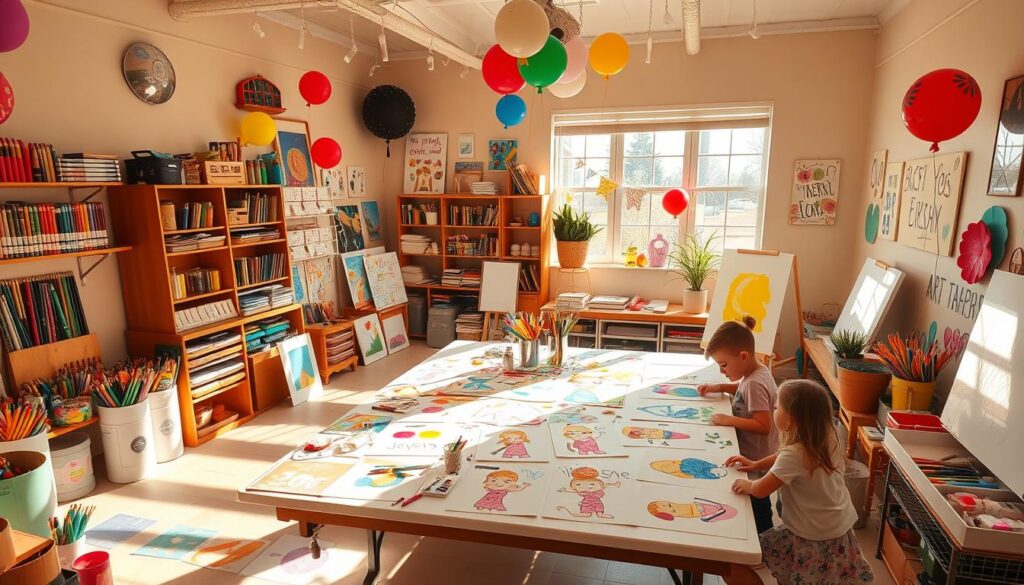
Let’s explore some fun art therapy techniques that support your child’s emotional growth:
- Emotion Color Wheel: Encourage kids to pick colors that show different feelings
- Feeling Masks: Make masks that show complex emotions
- Stress Relief Mandala Drawing: Use circular patterns to calm and center emotions
“Art enables children to process emotions they might struggle to verbalize” – Child Psychology Research Institute
The “Feelings Landscape” technique is a powerful art therapy exercise. Kids draw a landscape that shows their current emotional state. They use colors, shapes, and symbols to share their inner world.
When using these art projects for emotional development, keep in mind:
- Create a judgment-free space
- Give complete creative freedom
- Listen actively to your child’s artistic story
Art therapy exercises for kids can change how they communicate emotions. It offers a safe and creative way for them to understand and share their feelings.
Art Therapy for Kids: Creative Expression for Managing Emotions
Art therapy is a powerful way for kids to express their feelings. It lets them explore their inner world safely and meaningfully. Through art, they can share emotions that words alone can’t express.
Young minds often find emotions hard to handle. Art therapy gives kids special tools to deal with their feelings. It happens in a supportive place.
Color and Emotion Connection Activities
Colors are key in showing emotions. Kids learn to link colors with their feelings through art:
- Red might represent anger or excitement
- Blue could symbolize calmness or sadness
- Green might indicate growth or peace
Drawing Feelings and Emotions
“Art enables us to find ourselves and lose ourselves at the same time.” – Thomas Merton
Art like drawing helps kids show their inner feelings. They can use:
- Emotion landscape drawings
- Feeling face collages
- Abstract emotion sketches
Sculpting Through Difficult Emotions
Sculpting is a three-dimensional way to explore emotions. Kids can shape clay or play dough to work through tough feelings. They create a real picture of their emotional journey.
These art therapy methods help kids understand, process, and share their emotions. They do it in a creative and supportive way.
Integrating Art Therapy into Daily Routines
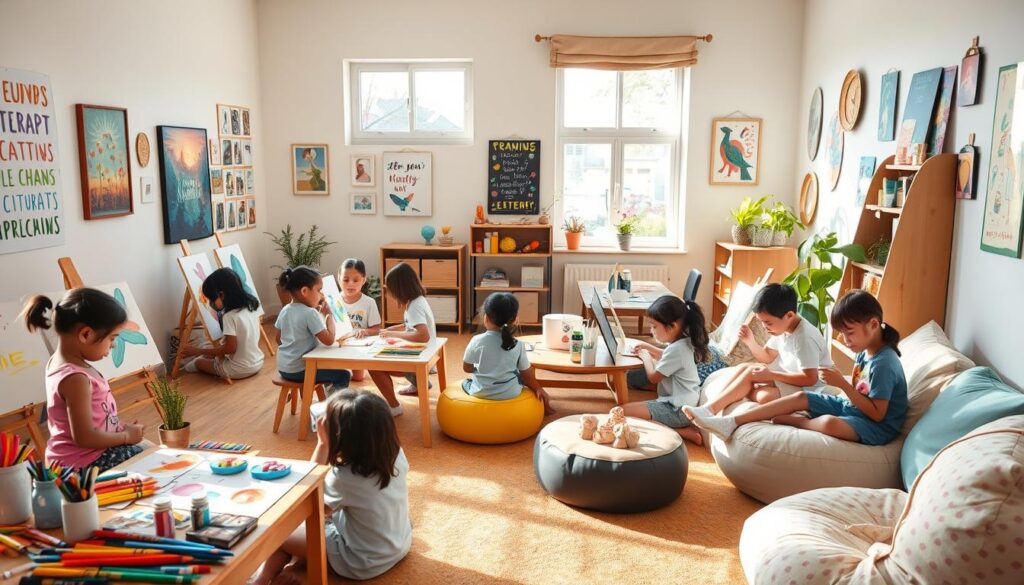
Adding art therapy to your child’s daily life is easy. You don’t need special training or equipment. Just simple, regular creative activities can help a lot. Making art a part of daily life helps kids express and handle their feelings better.
“Creativity is intelligence having fun” – Albert Einstein
Here are some easy ways to add art therapy to your family’s routine:
- Create a dedicated art corner with easily accessible supplies
- Schedule 15-20 minute creative sessions after school
- Use drawing as a communication tool during dinner or bedtime
- Encourage emotional storytelling through artistic expression
Art therapy should be fun and not stressful. Kids like activities that feel like play. Keep things simple with materials like colored pencils, watercolors, clay, and blank journals. These can be great tools for managing emotions.
| Age Group | Recommended Art Activity | Emotional Benefits |
|---|---|---|
| 3-5 years | Finger painting | Sensory exploration, mood expression |
| 6-8 years | Emotion color mapping | Feeling identification, self-awareness |
| 9-12 years | Journaling with sketches | Emotional processing, reflection |
The main thing is to create a safe space for your child to explore their feelings. By making art a natural part of their life, you help them develop important emotional skills for the future.
Supporting Children Through Art: Parent’s Guide
Art therapy is a great way for kids to learn about their feelings. As a parent, you play a key role in helping them grow emotionally through art.
Creating a supportive space for art therapy is important. It needs patience, understanding, and good communication. Your way of helping can make art a deep emotional journey for your child.
Communication Tips During Art Sessions
When you’re with your child making art, make sure it’s a safe place. Ask open-ended questions that help them think:
- What were you feeling when you created this?
- Can you tell me about the colors you chose?
- What does this artwork mean to you?
Responding to Emotional Artwork
Art can show deep feelings in kids. If your child shows you something intense:
- Listen carefully without judging
- Accept their feelings
- Don’t overthink or criticize
“Art enables us to find ourselves and lose ourselves at the same time.” – Thomas Merton
Building Trust Through Creative Expression
Trust is key in art therapy for kids. Show you care about their art by:
- Showing off their work
- Talking about their feelings freely
- Joining in on art projects
Your support turns art into a powerful tool for emotional growth and understanding.
Common Challenges and Solutions in Art Therapy
Art therapy for kids can be tricky for parents and caregivers. It’s not easy for kids to show their feelings through art. This can make it hard for them to express their emotions.
Parents face many challenges in art therapy. Kids might not want to do art or find it hard to show their feelings through it. This can be a big problem.
- Resistance to art activities
- Limited emotional vocabulary
- Short attention spans
- Fear of imperfection
“Art allows children to process emotions in a safe, non-threatening environment.” – Dr. Sarah Martinez, Child Psychologist
Here are some ways to solve these problems:
- Create a judgment-free zone
- Use age-appropriate materials
- Allow free artistic exploration
- Focus on the process, not the result
| Challenge | Solution |
|---|---|
| Emotional Blockage | Introduce feeling-based color activities |
| Low Motivation | Use interactive, playful art techniques |
| Performance Anxiety | Emphasize personal expression over perfection |
Remember, patience and consistent encouragement are key to helping children embrace art therapy as a powerful emotional outlet.
Measuring Progress: Growth Through Creative Expression
Watching a child grow through art can be very enlightening for parents and caregivers. Art lets us see into a child’s inner world. It shows us their emotional intelligence and how they are growing.
To understand art’s role in emotional development, we need to observe and document carefully. I suggest making a plan to track your child’s artistic growth.
Documenting Emotional Development
Keeping a visual journal of your child’s art can show big steps in their emotional intelligence. Here are some tips:
- Take photos of their artwork regularly
- Write down the emotions in each piece
- Watch for changes in color and technique
- See how they get better at expressing themselves
Celebrating Artistic Achievements
It’s important to celebrate a child’s artistic wins. This boosts their confidence and emotional growth. Set up a special place to show off their artwork and see how they’ve grown.
“Every stroke of creativity is a step toward understanding oneself.” – Child Development Expert
My way of tracking progress is through observing changes, not just numbers. Look for small but important changes in:
- The depth of emotions in their art
- How open they are to trying new things
- How well they express themselves
- How comfortable they are sharing their feelings through art
Art projects for emotional development are about feeling and expressing, not making perfect art. Each piece is a part of your child’s emotional story.
When to Seek Professional Art Therapy Support
It can be hard to know when your child needs professional art therapy. Art therapy helps kids manage their feelings, but sometimes they need a pro’s help.
“Early intervention can transform a child’s emotional landscape.” – Dr. Sarah Martinez, Child Psychology Specialist
Knowing when to get help is key for your child’s emotional growth. It helps parents act early to support their child’s feelings.
- Persistent emotional distress not resolved through home-based art therapy
- Significant behavioral changes or withdrawal
- Traumatic experiences requiring specialized emotional processing
- Diagnosed mental health conditions needing targeted art therapy techniques
Art therapists have special skills to help kids deal with tough emotions. They use advanced techniques to help kids understand their feelings better.
| Warning Signs | Recommended Action |
|---|---|
| Recurring negative artwork themes | Consult child psychologist |
| Extreme emotional resistance during art activities | Professional art therapy assessment |
| Inability to express feelings through art | Specialized emotional regulation intervention |
Looking for professional help doesn’t mean you’ve failed. It shows you care about your child’s emotional health. Art therapists offer special ways to help kids manage their feelings, more than just talking therapy.
Remember, every child’s emotional journey is unique, and professional guidance can be a transformative resource.
Conclusion
Art therapy is a powerful way for kids to deal with their feelings. It lets them express their emotions through art. This helps them understand and manage their inner world.
Parents are key in helping their kids with emotions. By supporting creative expression, they create a safe space for their children. Art becomes a way for kids to heal and learn about themselves.
Art therapy helps kids develop important skills. They learn to understand and control their emotions. It builds their confidence and teaches them to express feelings in a healthy way.
I think parents should see art therapy as important for their child’s emotional health. Every time a child creates art, they learn more about themselves. Art therapy helps kids face their emotions with creativity and strength.

